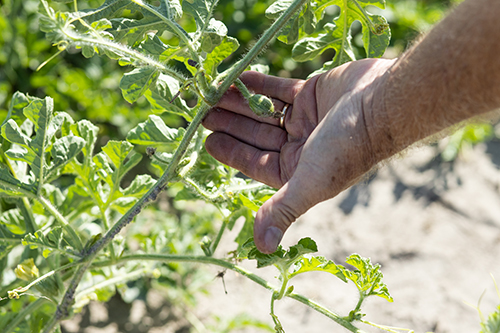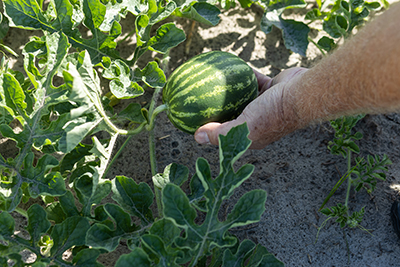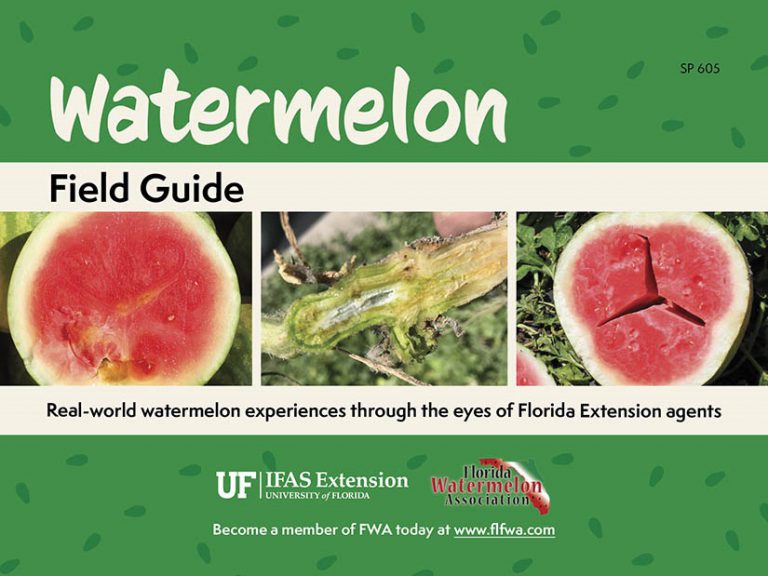And as consumers around the nation enjoy slice after slice of cool watermelon this summer, they can thank a dedicated network of Florida growers and University of Florida scientists for this refreshing warm weather treat.

Florida is the top producer of watermelon in the country, with planting in March and harvest in May and June. For many UF/IFAS Extension agriculture agents, this time of year means weekly visits to local watermelon fields, where they scope out early signs of disease, identify pests and test the plants’ sap to make sure nutrient levels are just right.
“Each of us has our own area of expertise and we lean on each other and our researchers to identify problems before they become an issue that could affect the whole industry,” said Bob Hochmuth, a regional specialized vegetable Extension agent.
Watermelon is grown all over Florida, but more than a third comes from the Suwannee Valley, where Hochmuth is the assistant director of the UF/IFAS North Florida Research and Education Center’s regional campus.
When an issue first emerges, Hochmuth and 11 other Extension agents in the region activate an alert system that informs growers and managers of approximately 50 watermelon farms — as well as many allied industries — about the potential threat and how to combat it.
“We put out the Weekly Watermelon Update every Monday, but sometimes we will send multiple messages a week when we’ve identified an issue that growers need to address right away,” Hochmuth said.
The week of May 10, one such issue reared its head: Gummy stem blight, a fungal infection that affects the stems and leaves of watermelon plants, was found in several fields in the area.
“When we have a potential outbreak of a disease, like gummy stem blight, we act fast to give growers the unbiased, science-based information on the disease and best practices for controlling it,” Hochmuth said.
The alert system is a combination of the core Extension principle of face-to-face outreach, and rapid, modern communication tools, growers say.
“The farmers of the Suwannee River Valley Tri-County area are tremendously lucky to have very willing and active county Extension agents that, through their collaborative efforts, work diligently to help us improve our farming practices,” said Laura Land,” said Laura Land of Jody Land farms. Land is past president of the Florida Watermelon Association.
“Currently they are very active with a weekly Tri-County area watermelon update sent out weekly in the form of text and email to all the growers in the Suwanee River Valley describing and diagnosing insects and diseases found throughout the week, helping the growers to have a proactive spray plan to combat the disease along with educating through leaf sap samples and water monitoring to use fertilizer recommendations to the best of our abilities,” Land said.
In addition to disease and pest information, the weekly update includes the latest news about weeds, pollination, weather, irrigation, food safety, field days and ongoing research projects.
“This past year we’ve also been able to share best practices for keeping agricultural workers safe during the COVID-19 pandemic,” Hochmuth added.
While the weekly update arrives as an email, agents also follow up with growers via a text messaging system, allowing them to reach growers while they are out and about on the farm. Growers can ask questions and send photos, all in real time. Agents also connect growers with rapid diagnostic services through UF/IFAS’ Soil Testing Laboratory and Plant Diagnostic Center.
All these efforts help watermelon farmers better run their businesses, said Doyle Williams, president of Double-W Farms in Worthington Springs.

“The UF/IFAS team provides us information that is integral to us being able to successfully make our crop. The weekly updates and farm visit are both important to us being as efficient as possible. It costs too much to take a shot gun approach, but we trust and depend on timely and rapid responses to our questions from IFAS,” Williams said.
For Courtney Davis of Gowan Seed Company, the weekly update provides insights for allied agricultural industries as well.
“I find the update is useful because it gives me an overview and summary of what is going on with North Florida when I’m not able to get up there every week myself,” Davis said. “The updates not only give an overview of North Florida conditions but also recommendations for problems you encounter as well. I like to hear about the progress of the crops, anything that we need to be aware of and solutions to our problems that are practical real-world solutions.”

Over the past several years, support from the Florida Watermelon Association has been critical to strengthening the network of Extension and industry professionals, Hochmuth said. For example, the association has recently supported the publication of a new pocket-size field guide that can be used on the farm to identify diseases, pests and other issues.
“In all my years with Extension — 40 years — I’ve never been so deeply involved in network like this. It’s been really rewarding to be a part of,” Hochmuth said.
 0
0
